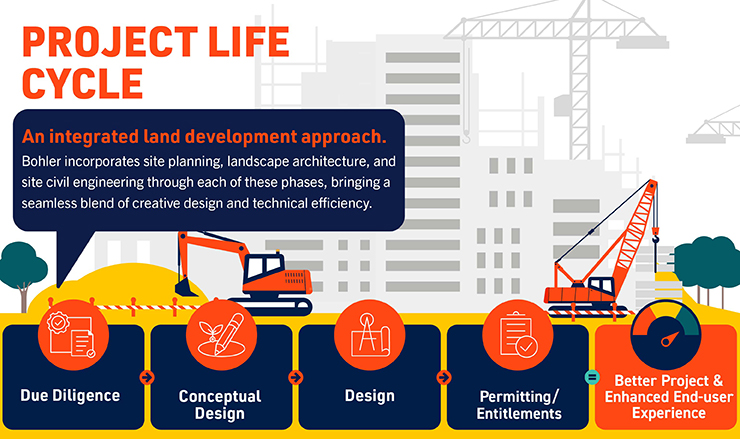Site Planning, Landscape Architecture, and Design
In land development, the importance of integrating site planning, landscape architecture, and site civil engineering services cannot be overstated. Incorporating each discipline’s perspective through each stage of a project’s life cycle results in a seamless blend of creative design and technical efficiency.
This approach brings stronger results and enhanced user experience. Landscape architects, in particular, play a crucial role in identifying creative solutions and end-user experiences on both macro and micro scales.
At Bohler, we provide site planning, landscape architecture, and design as an integral part of our land development design approach.
Our skilled planners and landscape architects work closely with our site civil engineers to develop and evaluate master plan and site design concepts. We focus on understanding a site’s inherent qualities and environmental assets in the context of jurisdictional requirements.

Project Scoping
Involve a planner or landscape architect before the project takes shape, during the preliminary steps of scoping a project. We bring a unique perspective to identifying site constraints, challenges, opportunities, and elements needing further clarification. This early engagement informs a more comprehensive scope, reduces surprises down the road, and allows for more informed decision-making, covering aspects like site analysis, environmental considerations, feasibility studies, and the creation of use/yield diagrams and density assessments.
Conceptual Design
Landscape architecture collaboration at the conceptual phase is all about integrating the functional design and engineering requirements of a site with environmental, character, and aesthetic design. Landscape architects focus on experiential aspects, contemplating how people will use and experience the space, ultimately contributing to placemaking. This includes considerations like shade availability, use of authentic materials and native plants, and both vehicular and pedestrian traffic flow, influencing the overall site layout.
Landscape architects enhance both cost- and experience-based value by identifying and evaluating opportunities to incorporate additional programming or integrating the site layout and engineered systems. For instance, in an office building design, positioning a stormwater pond to the front and incorporating an outdoor seating area with a walking path and littoral plantings transforms it into an amenity that adds value to the property.
Let’s Talk About Your Next Project!
Get in Touch
Design and Construction Documents
Landscape architects often take on the responsibility of carrying the vision through to the end of the project. While site civil engineers traditionally focus on the site’s functionality and technical aspects, landscape architects integrate character and functional details with design elements that make the project stand out.
Incorporating hardscape and landscape design, irrigation planning, custom detailing and material selections, wayfinding and signage design, site lighting design, and assisting with stormwater management and grading design at this phase reinforces the projects vision and integrates a holistic perspective. Ideally, the site design team works together to blend form, function, and environmental design considerations to deliver high-quality results that not only meet the project’s basic needs, but also enrich the project and end-user experience.
Related Insights
Related Projects
Ready to Move Forward?
Our approach makes a meaningful difference for our most ambitious clients. Contact us to learn more.
Let's Get Started